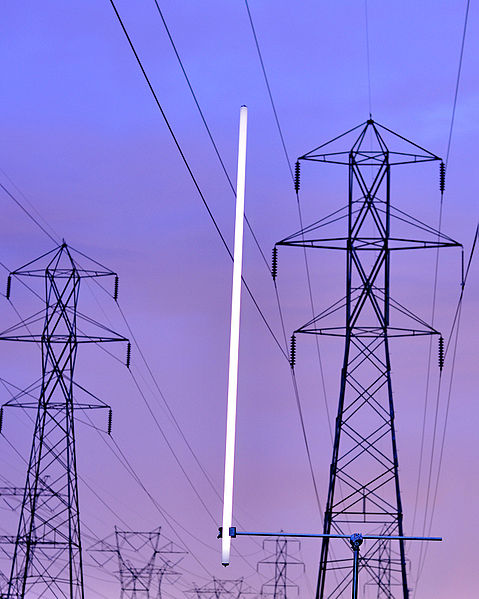The short answer to the question "what is navigated voltage?" is that there is no such thing. A slightly longer answer is that the correct term is "induced voltage".
I was searching the web for materials on transmission line electromagnetic fields when I came across the strange term "navigated voltage". I traced the source to Wikimedia where I noted that the image below is described in both English and Russian. The term "наведённого напряжения" on the Wikimedia page seems to have been wrongly translated as "navigated voltage". The correct translation is "induced voltage"

Fluorescent lamp lit by induced voltage under power lines.
Inductive effects in an electromagnetic field
When a conductor is placed in an electromagnetic field a voltage is induced across the ends of the conductor. That is the basic working principle of the common transformer. The induced voltage effect is widely known to cause fluorescent lamps to illuminate when placed near power lines and earthed at one end, but there is no practical application for such illumination.
Capacitive effects in an electromagnetic field
Any conductive material placed parallel to a cable carrying an alternating current will have a voltage induced on it in antiphase to the voltage in the cable. The cable and conductive material together form a basic capacitor. A short length of cable hung from a power cable by insulators forms a capacitor which can be used to provide a power source for a low-power neon tube. That is the design basis of the BALISORTM. (The trade mark is owned by OBSTA.)

The BALISORTM
A typical balisor is just under 1 meter long and the capacitor is formed from a conductor about 4 meters long. The operating principle is very basic. As the voltage in the line parallel to the balisor conductor rises or falls from zero the capacitor charges. When the voltage across the neon lamp reaches the striking voltage of the neon it illuminates. When the voltage falls below the discharge sustaining threshold the light is extinguished. The voltage rises and falls 50 or 60 times per second, so the neon illuminates 100 or 120 times per second. To the human eye it is permanently lit.
Aviation safety
Placing beacons on pylons is not sufficient to ensure aviation safety where there are very long spans of cable. Power lines can readily be fitted with balisors. They make power lines visible from a greater distance. These devices, being powered capacitively from the line on which they are hung are ideal for power cable hazard marking where this is needed, since they need no separate power supply or transformer and need no second conductor.
ICAO and FAA regulations specify that power cables, tall towers and buildings etc. near airports must be lit with warning beacons. The balisor complies with ICAO LIOL Type A requirements.
ICAO Annex 10
ICAO LIOL - Low Intensity Obstruction Lights Types A and B.
Both A and B apply to obstacles that do not exceed 45 meters in height.
Type A is 10 cd and "shall be spaced at longitudinal intervals not exceeding 45m (150ft)".
Type B is 32 cd and "shall be spaced at longitudinal intervals not exceeding 900m (2950ft)".
Quite apart from safety aspects, in my opinion aviation safety markers can enhance the aesthetic qualities of structures.

image courtesy Wikimedia.





Comments